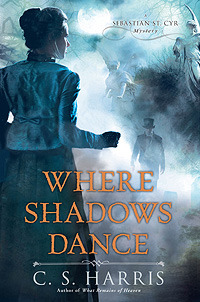 Where Shadows Dance (Sebastian St. Cyr, #6) by C.S. Harris
Where Shadows Dance (Sebastian St. Cyr, #6) by C.S. Harris Format: ebook
Source: purchased from Amazon
Formats available: hardcover, paperback, ebook, audiobook
Genres: historical fiction, historical mystery, mystery
Series: Sebastian St. Cyr #6
Pages: 342
Published by Berkley, New American Library on March 1, 2011
Purchasing Info: Author's Website, Publisher's Website, Amazon, Barnes & Noble, Kobo, Bookshop.org, Better World Books
Goodreads
How do you set about solving a murder no one can reveal has been committed?
Regency London, July 1812.
That's the challenge confronting C.S. Harris's aristocratic soldier-turned-sleuth Sebastian St. Cyr when his friend, surgeon and "anatomist" Paul Gibson, illegally buys the cadaver of a young man from London's infamous body snatchers. A rising star at the Foreign Office, Mr. Alexander Ross was reported to have died of a weak heart. But when Gibson discovers a stiletto wound at the base of Ross's skull, he can turn only to Sebastian for help in catching the killer.
Described by all who knew him as an amiable young man, Ross at first seems an unlikely candidate for murder. But as Sebastian's search takes him from the Queen's drawing rooms in St. James's Palace to the embassies of Russia, the United States, and the Turkish Empire, he plunges into a dangerous shadow land of diplomatic maneuvering and international intrigue, where truth is an elusive commodity and nothing is as it seems.
Meanwhile, Sebastian must confront the turmoil of his personal life. Hero Jarvis, daughter of his powerful nemesis Lord Jarvis, finally agrees to become his wife. But as their wedding approaches, Sebastian can't escape the growing realization that not only Lord Jarvis but Hero herself knows far more about the events surrounding Ross's death than they would have him believe.
Then a second body is found, badly decomposed but bearing the same fatal stiletto wound. And Sebastian must race to unmask a ruthless killer who is now threatening the life of his reluctant bride and their unborn child.
My Review:
Once upon a time, back in 2005, author C.S. Harris created a character who was the epitome of the typical Regency romance hero, tall, dark and brooding, handsome and aristocratic, a veteran of the Napoleonic Wars and damaged by his service, plagued by dark thoughts and even darker secrets.
Then she invested him with a desire, bordering on compulsion, to investigate the darker corners of the society he by rights should sit on top of, and set him on a course to balance the scales of justice no matter the position of whosoever gets crushed by their weight.
Thus began the Sebastian St. Cyr historical mystery series with What Angels Fear, defying expectations from the very first page.
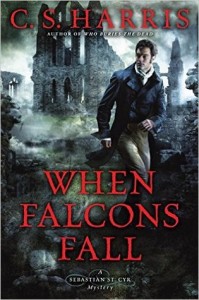 I was hooked back in 2005, and devoured the first five books in the series as they were published. Until, as so many things do, the series got caught up in the black hole of “so many books, so little time” and I stopped following until I was asked to review the eleventh book in the series, When Falcons Fall, for Library Journal in 2016.
I was hooked back in 2005, and devoured the first five books in the series as they were published. Until, as so many things do, the series got caught up in the black hole of “so many books, so little time” and I stopped following until I was asked to review the eleventh book in the series, When Falcons Fall, for Library Journal in 2016.
And I was hooked again.
I always intended to go back and read the ones I missed, but we’re back at that “so many books, so little time” thing again. This year I’ve decided to make a deliberate effort to read at least the earliest books on my various wishlists, and the gaps I left in reading this series appeared on every list.
So I’ve returned to Regency England and Sebastian St. Cyr, Viscount Devlin, as he reaches the turning point in his life that all those later books in the series presented as a ‘fait accompli’ In 1812, Where Shadows Dance, that thing is just at the beginning of being decided as political factions in Britain are debating just how many of their own fronts they must defend as they determine which – if any – of their allies to aid in the ongoing war with Napoleon.
Amidst all the political turmoil, Devlin’s friend and former comrade-in-arms and current Scotland Yard pathologist (such as that job is in 1812), Dr. Paul Gibson discovers that someone has passed off a murder as a heart attack when he conducts an illicit autopsy on a body he’s not supposed to have, from a source he’s not supposed to know, committing a crime he can never admit to. All he knows is that the young and very dead Foreign Service agent on his autopsy table is the victim of a murder that someone seems to have been desperate to cover up.
Gibson knows one other thing – that his friend Devlin can be trusted to find the truth about the case – no matter how many people in high places are determined to cover it up.
Escape Rating A+: This turned out to be the perfect book to serve as a return to an earlier point in the series. Devlin is facing a personal crossroads, as he has been forced to set aside both the dreams and the defiances that marked his earlier life. He’s about to turn a new page and is aware enough of that to begin a consideration of how his own life has to change – changes that have been made manifest by the later books that I have already read.
Very much at the same time, and part of what continues to fascinate me in this series, is the way that the author weaves an intensely felt sense of the time and place in which Devlin lives with a historical setting filled with conflict and change that becomes both background and foreground to a murder mystery that satisfies readers who are there for the whodunnit.
This story takes place in 1812, a date that should sound familiar to any American reader as U.S. history named a war after it. From our perspective, the War of 1812 might be the only history we remember from that year, but from a British perspective, particularly at the time, the possibility that the U.S. might be itching for an opportunity to invade and take Canada wasn’t the biggest threat on the horizon.
That position was very much reserved for Napoleon Bonaparte, with whom Britain was still most definitely at war. As was most of the rest of Europe. Britain is in negotiations with seemingly all of Napoleon’s enemies, including the Ottoman Empire, Sweden and particularly Russia. Some in Britain want to send troops and/or money to all of the above, while many are more cautious about opening a second front just in case those pesky Americans get too obstreperous about the continuing seizure of American sailors by the British Navy.
The political maneuvering is in the background of the story when Gibson discovers that the body he intended to open up in order to learn more about heart disease turns out to have already been opened up by a stiletto to the spine. That the young cadaver worked in the Foreign Service and seems to have been in those frantic negotiations up to his neck is just the barest hint of the shenanigans that Devlin eventually uncovers – one confusing, conflicting piece at a time.
What makes this series – and this particular entry in it – continue to work for me is its combination of very effective elements. Not just Devlin, but all of the people who populate his slice of Regency England are utterly fascinating and most importantly feel like whole and wholly real, people. Even though I know they (mostly) weren’t. I still feel for them and with them and care about them. Or occasionally hate them – just as Devlin does.
The portrayal of the historical period feels spot on. My own studies brushed on this era a bit, but not nearly enough to catch inaccuracies in the details. It still feels right, to the point of sensing the cobbles under my feet and smelling the stink of Gibson’s utterly inadequate mortuary.
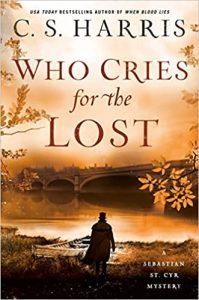 And I love the way the known historical conflicts of the time, both in government in England and in the wider world, are neither ignored nor brushed aside but instead inform every aspect of the mystery and give it depth and substance. All while a murder is committed, the crime is investigated, and evil gets its just desserts even as the story acknowledges that there are plenty of other – and often worse – evils afoot in that wider world that Devlin has yet to deal with. If he can.
And I love the way the known historical conflicts of the time, both in government in England and in the wider world, are neither ignored nor brushed aside but instead inform every aspect of the mystery and give it depth and substance. All while a murder is committed, the crime is investigated, and evil gets its just desserts even as the story acknowledges that there are plenty of other – and often worse – evils afoot in that wider world that Devlin has yet to deal with. If he can.
Those are the elements that keep me turning pages while I’m reading one of Devlin’s investigations, and keep me coming back for more. So I absolutely will be back, both for my continuing explorations of those books I missed, and for Devlin’s latest investigation in Who Cries for the Lost, coming this April.









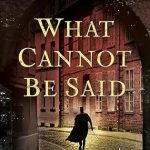
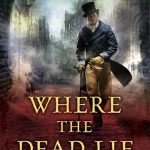
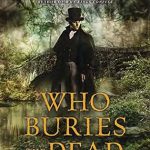
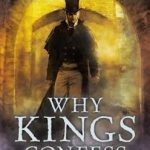
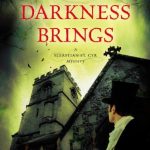









One thought on “Review: Where Shadows Dance by C.S. Harris”
Comments are closed.